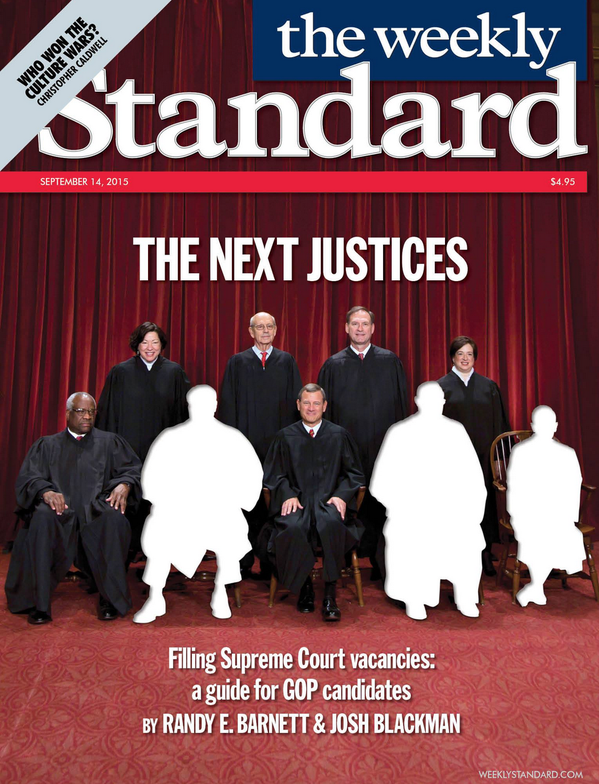The Volokh Conspiracy
Mostly law professors | Sometimes contrarian | Often libertarian | Always independent
Beyond the Clichés: 5 guidelines for selecting Supreme Court justices
Josh Blackman and I have written this week's cover article for The Weekly Standard: The Next Justices: A guide for GOP candidates on how to fill Court vacancies. Our five guidelines are
- Bruising confirmation battles are worth the political capital for a lifetime appointment
- Paper trails are an asset, not a disqualification
- Reject clichéd calls for 'judicial restraint'
- Focus on the Constitution, not issues du jour
- Focus on clauses, not cases
With respect to Guideline #1, I have been on record since 2005 with this Volokh post responding to the selection of John Roberts: Who is John Roberts? Who Knows? Nominating "stealth" candidates to avoid confirmation battles has lead to some deeply disappointing rulings. You can name your own favorite; you probably can guess mine.
To avoid this, in Guideline #3, we urge the Republican presidential nominees to get beyond the failed manipulable tropes of "judicial restraint" and "not legislating from the bench." Here is a tease:
Compare the two nominees of [President George W. Bush]. In National Federation of Independent Business v. Sebelius, Chief Justice Roberts found that Obamacare's individual mandate exceeded Congress's powers under the commerce clause. But he didn't stop there. After finding the law Congress wrote was unconstitutional, the chief justice then employed a "saving construction" to rewrite the mandate so he could uphold it as a tax. This he did in the name of judicial restraint and deference to Congress. In contrast, in his dissent, Justice Alito agreed that Congress lacked the authority to enact the mandate. However, unlike the chief, Alito rejected calls for a saving construction. He would have invalidated Obama-care in its entirety.
Despite his insisting to the contrary, it was the chief justice who rejected judicial restraint by rewriting the unconstitutional law so he could uphold it. It was the chief justice who quite literally drafted a new statute "from the bench." In contrast, Justice Alito ruled based on his reading of the Constitution, and would have invalidated the law Congress wrote. "Judicial restraint" and "deference to the legislature" are easily manipulable concepts that distract attention from what really should matter to any constitutionally conservative voter or president: Who has the fortitude to follow the Constitution wherever it may lead and let the chips fall where they may? Any judicial nominee can claim he or she will be "restrained" or "deferential" but what exactly do they think "restrains" them? The popularly elected Congress, or the popularly enacted Constitution? Invocations of "restraint" and "deference" are designed to avoid this crucial issue. The same goes for deference to the executive and its administrative agencies.
Presidential candidates should reject the vapid labels of "restraint" and "legislating from the bench" and focus instead on what a prospective nominee's proven track record and paper trail (see above) say about his or her constitutional philosophy. The heart of the inquiry should be whether the nominee is willing to engage and enforce the Constitution against the other branches, not whether they can parrot clichés about "strict constructionism" or "calling balls and strikes" during a confirmation hearing.
The cover is cool too:

Read the whole thing here.



Show Comments (0)